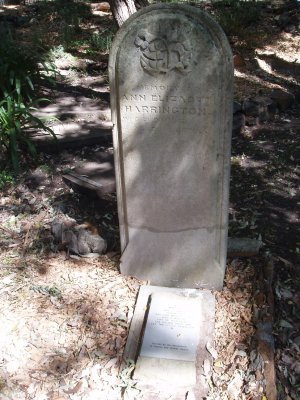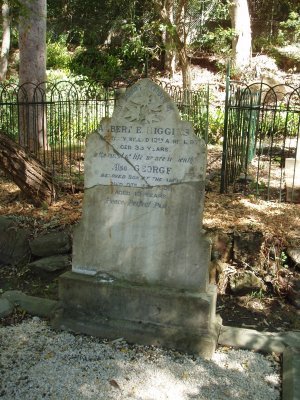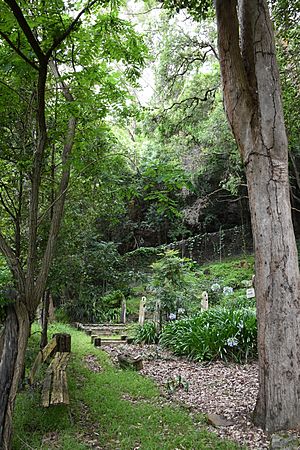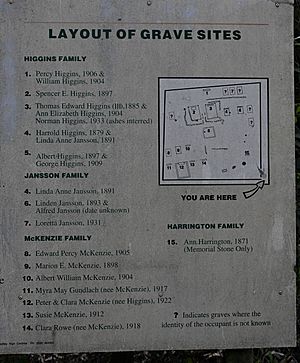Old Man's Valley Cemetery facts for kids
Quick facts for kids Old Man's Valley Cemetery |
|
|---|---|
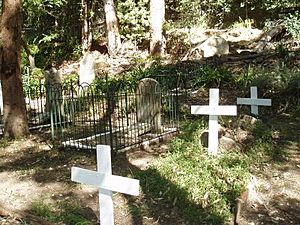 |
|
| Location | Old Man's Valley, off Quarry Road, Hornsby, Hornsby Shire, New South Wales, Australia |
| Built | 1879–1931 |
| Architect | Members of the Higgins family |
| Owner | Hornsby Shire Council |
| Official name: Old Man's Valley Cemetery; Higgin's Family Cemetery; Old Mans Valley Cemetery; Higgins Family Cemetery | |
| Type | State heritage (complex / group) |
| Designated | 22 December 2006 |
| Reference no. | 1764 |
| Type | Cemetery/Graveyard/Burial Ground |
| Category | Cemeteries and Burial Sites |
| Builders |
|
| Lua error in Module:Location_map at line 420: attempt to index field 'wikibase' (a nil value). | |
The Old Man's Valley Cemetery is a special place in Hornsby, Australia. It's a heritage-listed former cemetery that is now a memorial area. It was built by members of the Higgins family between 1879 and 1931. The cemetery is also known as Higgin's Family Cemetery or Higgins Family Cemetery. Today, the Hornsby Shire Council owns this important historical site. It was added to the New South Wales State Heritage Register on December 22, 2006, because of its special history.
Contents
Discovering Old Man's Valley History
Aboriginal Connections
Old Man's Valley has a deep connection to Aboriginal history. A book called Haunted Earth by Peter Read shares a story about this area. An Aboriginal man named Dennis Foley, whose family's traditional land is nearby, visited the valley.
'[We] drove up the ridge to the Hornsby site. As he looked at the map in the car, Dennis' pulse quickened. Long before we arrived, he knew where we were going. In the company of his Gai-mariagal elder, Uncle Gar, who had taught him so much of the lore of the sandstone, he had already been there as a child. 'Travelling in the late 1950s from Fairfield, with his own son and Dennis, to go fishing at Bobbin Head, Uncle Gar had detoured five kilometres to Hornsby, to show the boys the site, amongst the highest points on the ridge that divides Berowra Creek from Cowan Creek. Perhaps, Dennis now wonders, he wanted to pay his own respects. From his uncles, Dennis learnt that Old Man's Valley is a woman's site in the edge of the escarpment, a dolerite outcrop, female to the relational male dolerite hill, already mined to destruction, near Blacktown on the western Sydney plain. A freshwater spring, now evidently dry or destroyed, used to bubble from the bottom of what is now a quarry. Traditionally, it was guarded by Gurang, the old Kangaroo people - perhaps this is why the area is still known as Old Man Valley. The boys were told to stay in the car while Uncle Gar muttered words under his breath, and walked agitatedly about the site. Dennis says: I remember he was like a startled rabbit.'
—Peter Read, in Haunted Earth.
This story shows that the valley was a very important place for the Aboriginal people. It was a sacred "woman's site" with a freshwater spring. The "Gurang," or Kangaroo people, traditionally protected it.
European Settlers Arrive
The Higgins family, who started the cemetery, were early European settlers. They were descendants of Thomas Edward Higgins and Eleanor McDonald, who arrived in Australia on the Second Fleet. Eleanor's first husband, David Killpack, was a First Fleet convict. He was given land in the Field of Mars area, which is now Carlingford.
Eleanor and David were the first free settlers in what is now Hornsby Shire. After David died, Eleanor married Thomas Higgins. Their son, Thomas Edward II, was born in 1800. Thomas Edward II later received a land grant in a fertile valley. He named it Old Man's Valley and became the first settler in the Hornsby area.
After Thomas Edward II passed away, his son, Thomas Edward III, inherited the land. His large family formed the community in the valley. It's believed that Thomas Edward III started the cemetery when his youngest son, Harrold, died. The cemetery was likely made a sacred Anglican burial site when Thomas Edward III was buried there in 1885.
The oldest inscription in the cemetery is from 1871 for Ann Elizabeth Harrington, a 14-month-old girl. However, she was not buried there; the stone is a memorial. Between 1879 and 1931, 25 people were buried in the cemetery. Family members also believe that many babies were buried in unmarked graves near the eastern edge. The cemetery was important because the valley was isolated, making it hard to take people to other burial grounds. It also showed the strong connection the Higgins family had to their land.
In the early 1900s, rules about burials became stricter. In 1931, special permission was needed to bury Loretta Jansson due to hard times during the Great Depression. Later, it became easier to transport the dead with cars. By the late 1960s, the last Higgins family members left the valley. A monument was put up in 1970 to honor the pioneering Higgins family.
Cemetery Falls into Disrepair
Old photos from around 1910-1920 show the cemetery looking neat. It had a timber fence and was kept clear of fires. Families planted flowers like alyssum, violets, lilies, and roses around the graves. Later photos from the 1960s-1980s show other flowers like snowdrops.
By the late 1920s, the timber fence was replaced with wire. A clipped hedge also marked the boundary. After the 1930s, the cemetery wasn't used for new burials, but family members still living in the valley sometimes looked after it.
Sadly, in the late 1950s and early 1960s, vandals attacked the cemetery. Many grave fences were broken, and parts of headstones were smashed. Photos from the mid-1960s show the cemetery neglected and damaged. Another major attack happened in 1969. A new timber post and wire fence was put up around that time.
Quarrying in the Valley
Around 1903, a quarry started operating in Old Man's Valley. They dug for "blue metal," a type of rock used for roads. Horses pulled the rock up the steep hills. By the 1920s, the quarry was very busy. The Hornsby Shire Council took over the lease to run it.
Later, Hornsby Road Metal Limited took over. They used a narrow railway line and then a chain of buckets to move the crushed rock. During the 1930s, bushwalks were created around the quarry to help people find work during hard times. The quarry closed during World War II but reopened in the 1950s.
Different companies operated the quarry over the years. They produced materials for roads. Eventually, the quarry became less profitable because the rock quality wasn't as good, and cheaper materials became available.
Hornsby Council Takes Over
Because the quarry was no longer making much money, the owners, CSR Ltd, decided to sell it. On March 22, 2001, they told the Council they wanted them to buy the site. The Council got approval to buy the quarry and nearby land on May 9, 2002. The ownership was officially transferred on May 31, 2006.
Higgins Family Helps Save the Cemetery
In 1992, a plan was made to restore the cemetery. Work began with an archaeologist named Siobhan Lavelle guiding volunteers, including members of the Higgins family. A stonemason repaired graves, and family members fixed metal fences around the plots. A security fence was put up, and drainage work was done to protect the site. The project finished in March 1994.
Part of the plan was to create educational materials. An interpretive sign was put up at the cemetery, and a brochure was made. The New South Wales Government helped fund this work. This was one of the first times public money was used to help save a private cemetery. The National Trust of Australia and Higgins family descendants also contributed money. Hornsby Council and the quarry owners helped too.
Since 1998, Hornsby Council has held Open Days and guided bushwalks in Old Man's Valley, including tours of the cemetery. Guides and Higgins family descendants also lead educational tours for the National Parks and Wildlife Service. These tours help people learn about the early European settlement and the history of the area. The cemetery has become a very important heritage site, showing how communities can work together to preserve history.
Old Man's Valley Timeline
Here's a quick look at the history of southern Old Man's Valley:
- Pre-European – Aboriginal people lived in the Hornsby area.
- 1820 – The Higgins family settled here, becoming the first Europeans to live permanently in Hornsby. Thomas Edward Higgins was promised land in 1823.
- 1830s-1880s – The Higgins family cleared land for orchards and gardens. Thomas Higgins died in 1885 and was buried in the family cemetery.
- Late 1880s – Parts of the Higgins land were sold and divided. The rest continued to be farmed by family members.
- Early 1900s – Mining started, and the quarry opened to dig for "blue metal."
- 1920s – By 1924, the quarry was very busy, run by Hornsby Road Metal Ltd. Later, Hornsby Council leased it.
- 1930s-1950s – The quarry was worked on and off by the Council.
- 1951 – The area was zoned as Green Belt.
- 1954-1959 – The Council leased the quarry to another company, and rock production greatly increased.
- 1959 – Hornsby Blue Metal Pty Ltd took over the quarry lease.
- 1977 – The quarry area was zoned as Open Space.
- 1988 – The Old Man's Valley (Higgins) Cemetery was listed by the National Trust.
- 1990 – The Cemetery conservation project won a Hornsby Council heritage award.
- Late 1990s – The quarry continued to operate until it was no longer profitable.
- 1994 – The study area was zoned as Open Space under the Hornsby Local Environmental Plan.
- March 2002 – CSR Readymix told the Council to acquire the quarry site.
- May 2002 – The Council officially began owning the quarry site.
- February 2004 – The Council started planning studies for the area.
What the Cemetery Looks Like
The Old Man's Valley Cemetery is surrounded by a fence and is near a road leading to Hornsby. The ground slopes steeply from east to west. There are at least 23 known burials here, but only 15 marked gravestones and five marked but unnamed graves are still visible.
When it was first created in the 1880s, the cemetery was probably a square area, about 20 meters by 20 meters. The current security fence is a few meters back from the original boundary.
The first graves faced east, which was a common tradition. As more people were buried in the early 1900s, the cemetery became more organized. Different family groups had their own sections. The McKenzie family plots were in the southeast, the Jansson family plots in the northwest, and the Higgins family plots were in the middle and western areas. Unmarked graves for infants were along the eastern edge.
The oldest headstones are made of sandstone, but most are marble. You can still see parts of old grave decorations, like iron fences with looped railings, sandstone borders, and fancy "barley twist" cast iron railings. Some borders were made with white bricks placed diagonally.
Paths connect the graves, and there are informal gardens with native shrubs. You can also see some of the original flowers planted by families, like alyssum, violets, lilies, and freesias.
The cemetery is surrounded by native forest, including eucalyptus trees, mixed with some introduced plants like privet and black locust. These trees make the cemetery a peaceful place and hide it from the nearby quarry and houses.
An interpretive sign in the northeast corner tells the cemetery's history and identifies the graves. This sign is near the double gate, which is the only way to enter the site.
Since about 1990, the cemetery has been looked after by family descendants. They have uncovered grave borders and some previously unknown stones.
Condition of the Cemetery
The cemetery was damaged by vandals in the mid-1900s. Many grave railings and headstones were broken. However, thanks to a big restoration project in 1992-1994 and ongoing care, the cemetery has been mostly returned to its original state. While some monuments can't be fully fixed, most are in very good condition. The cemetery's design and layout have been carefully kept. Some inscriptions are fading due to weather, but important ones have been copied onto metal plaques near the monuments.
The cemetery is now in good shape. Family members continue to maintain and visit it, helping to preserve it for the future. The restoration work in 1992 followed professional guidelines, using old photos and documents to guide the repairs. The cemetery has been regularly maintained ever since.
Changes Over Time
Old photos show that the monuments in the cemetery were fairly standard. Early headstones were sandstone, but most were marble. The most elaborate monument was a sculpted angel on the grave of Spencer E. Higgins from 1897, but this monument no longer exists.
Early 1900s photos also show other grave decorations, like fancy "barley twist" cast iron railings and borders made of white bricks. Only a few pieces of these remain today. Other graves had simple iron fences or sandstone borders. The original wooden fence and privet hedge around the cemetery are mostly gone.
In 1992, a plan was made to restore the cemetery. An archaeologist, a stonemason, and Higgins family volunteers worked together. A security fence was put up, and drainage was improved. An interpretive sign was also added to the site.
Why Old Man's Valley Cemetery is Important
As of December 21, 2006, the Old Man's Valley Cemetery was recognized as very important to the state of New South Wales. It's rare because it's one of the few family cemeteries in New South Wales that has been fully preserved, and possibly the only one.
It's also important because of the strong community effort to save it. Many Higgins family descendants, who now live all over Australia, have helped fund its preservation and even volunteered their time and effort. The cemetery is also important to the wider community. Visitors, cemetery fans, and schools come to learn about its history.
The Hornsby Shire Council took ownership of the cemetery in 2006. It serves as a great example of how a family cemetery can be preserved and valued for future generations.


